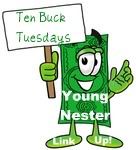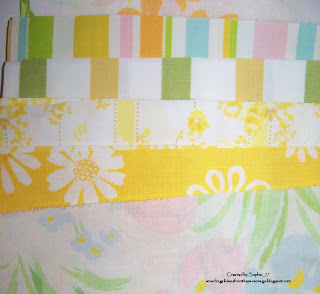If you're on a sewing kick and (like me) go through 10 regular (400-yd) spools of thread in a month, you know that thread expense can add up. It's one of those hidden costs that you don't think about when you're starting a project.
After I went through those ten spools of thread in one month, I was on the lookout for a good way to save money on it. Even though I got them for $1 each on sale (a great deal considering they're usually $1.99 or more), $10 a month for thread is a bit more than I was willing to part with. I know, I'm cheap! :)
At any rate, as I was reading library books on the subject of machine quilting, I came across a tip that is worth every late fine I've ever paid at a public library! It's from the book
Machine Quilting: A Primer of Techniques by Sue Nickels. If you're looking for the best book to introduce you to machine quilting, this is it. Don't let the cover fool you - it's not all about fancy embroidery machine stitches. It's the most practical, helpful book I've read on the subject. (And I've read upwards of ten, so you can trust me on that.)
But let's get on to the tip ... You've probably seen those wire hanger-type things that are designed to adapt cone thread to a regular sewing machine. Well, you don't need to buy that wire hanger-type thing to use inexpensive cone thread on your regular sewing machine. Check this out:

You simply place the cone on the table behind your sewing machine. Then place a bobbin either on the spool holder (which didn't work on my machine) or on the bobbin-winding-pin (whatever the technical name might be). Pull the thread through the little hold in the top of the bobbin and thread your machine as usual.

Here you can see how it works on my machine. You may have to experiment just a little bit for your machine, but it's fairly easy. You just want the thread coming from the same general direction as the spool pin usually feeds it.
In order to wind a bobbin with the cone thread, I simply threaded my machine as usual and held the cone in my left hand, just slightly behind the machine, on level with the top. It doesn't require as much coordination as it sounds.
I haven't had any problems with the cone tipping over and rolling around on the table. I'm about halfway through with the cone, so I'll be sure to let you know if it becomes a problem - and what solution I come up with. :)
So, how much money can you save this way? I bought this 3000-yd cone at full price (Hancock's) for $2.99. I would have paid $7.50 for that same amount of thread at the
sale price (400-yd/each), and almost $15 for that same amount of thread at
full price.
This thread is 100% polyester. Since I do most of my sewing with poly/cotton blends, it works great for me. If you do quilting with 100% cottons, you'll probably want to shop around for cotton thread on a cone. I didn't look for any, but I'd guess they're out there - and for a lot cheaper than regular spools. If you go to thrift shops as much as I do, you've probably even seen a few industrial-sized cones, too. They're generally as cheap as dirt in a thrift store, but be sure to check the fiber content.
I hope this helps you as much as it has me!




















































- "Join Me on Facebook!
Contact